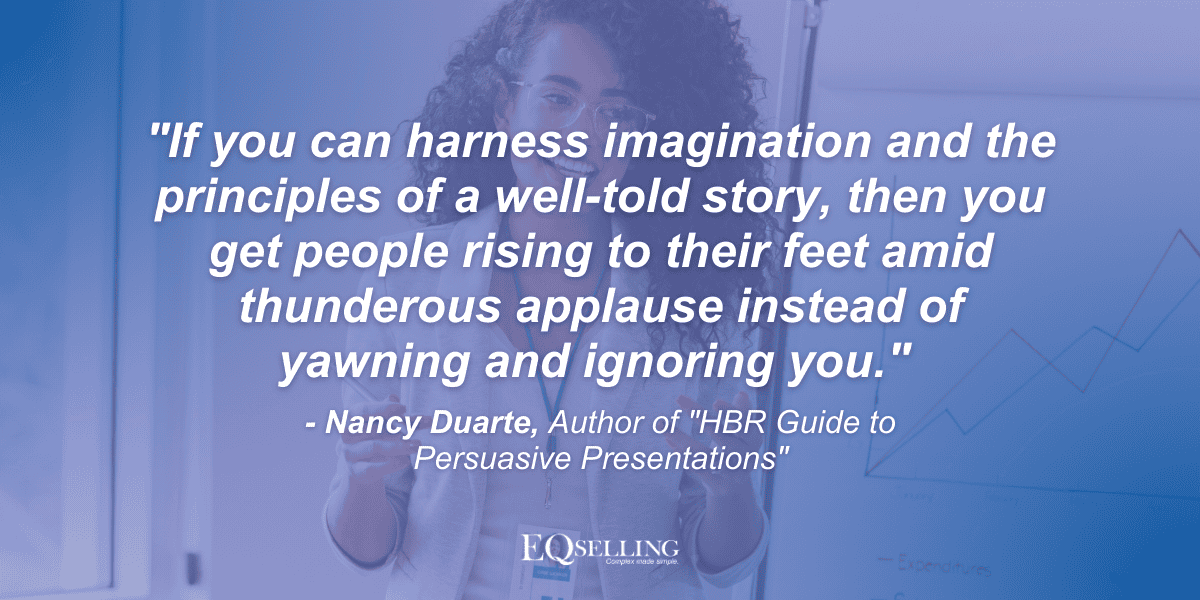Master the Art of Sales Storytelling
Between rushed reps racing through features and clients zoning out mere minutes into meetings, it’s no wonder the average sales demo falls flat. Even with immaculate upfront discovery, poor presentation delivery renders those efforts moot.
You can bookmark personal research and process documentation until you’re blue in the face. But if you can’t translate those insights into a captivating product storyline that puts buyers into the narrative driver’s seat, you’ve already lost.
“We need to conduct sales presentations like telling a clear story with a beginning, middle, and end – using language that brings the customer along visually.”
~John Rudow
The “Show and Tell” Anti-Pattern
I witnessed a cringe-inducing example of this anti-pattern when my son frantically attempted to walk me through his newest video game…
Within seconds he was manically hopping between screens, spewing breathless exposition around features and capabilities – rarely pausing to ensure I grasped what was happening or why I should care.
Before you knew it I’d zoned out, mentally checking out as the incoherent stream of buzzwords and mechanics flew over my head. I retained nothing of value, fixating on the game’s perceived complexity rather than its core benefits.
Sound familiar? That’s exactly how we often inadvertently condition buyers during disjointed presentations and haphazard product demos when we:
-
- Rapidly click-through screens or slide advancers without context.
- Speak in technical jargon rather than business language.
- Forget to check in with the client to ensure they’re still following along.
- Go off-script waxing about nifty bells and whistles.
- Fail to reinforce key client requirements or use cases.
You may be enthusiastically championing a solution you deem invaluable. But if the narrative thread never resonates with your audience, they simply disengage – thinking about other priorities, checking phones, or weighing alternatives from competitors who did tell a coherent story.
The Power of Storytelling in Sales
Effective sales storytelling is the antidote to the conventional pitfall. By weaving a captivating narrative around your product or service, you can keep buyers engaged, invested, and ultimately, convinced.
As the storyteller, your role is to:
-
- Set the stage with a riveting opener that hooks their attention.
- Introduce key characters (client companies, roles, challenges).
- Advance the plot with clear turning points and narrative tension.
- Resolve storylines with payoffs demonstrating your solution’s impact.
- Prompt self-realization through rhetorical questions and empathy
Crafting Your Sales Story: Tips and Techniques
To become a master storyteller, follow these tips and techniques:
-
- Know Your Audience: Conduct thorough persona research and discovery to understand your client’s pain points, challenges, and aspirations. This will help you tailor your story to resonate with their specific needs.
- Develop a Story Structure: Every great story has a beginning, middle, and end. Structure your presentation accordingly, introducing the protagonist (your client), their conflict (the challenge they face), the journey (your solution), and the resolution (the desired outcome).
- Put Your Client in the Story: Make your client the hero of your story. Describe their journey in a way that they can see themselves overcoming obstacles and achieving success. Use real-life examples that mirror their experiences, showing how your solution has helped clients like them. This approach makes the story more relatable and impactful.
- Leverage Emotion: Weave emotional elements into your narrative to captivate your audience. Share anecdotes, use descriptive language, and evoke feelings of empathy, curiosity, or aspiration.
- Incorporate Visuals: Visual aids, such as images, videos, or product demonstrations, can enhance your storytelling and make your message more memorable.
- Practice, Practice, Practice: Refine your delivery by practicing your story aloud. Seek feedback from colleagues or record yourself to identify areas for improvement.
The Storyteller’s Payoff
By mastering the art of sales storytelling, you’ll captivate your audience from start to finish, leaving them engaged, invested, and eager for the climactic grand finale. Storytelling not only makes your presentations more memorable but also fosters stronger connections with clients, builds trust, and ultimately, increases your chances of closing deals.
Don’t let another sales opportunity slip away due to a lackluster pitch. Embrace storytelling as your secret weapon, and watch as your clients become enthralled by the narratives you weave.





